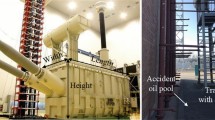Abstract
With 110 kV oil-immersed transformer as the platform, in this paper, we build a full-scale test platform covering 6 fire extinguishing (fire control) methods and different extinguishing agents, which is available for transformer fire extinguishing tests consistent with actual fire conditions. Through a transformer fire extinguishing test consistent with the real situation, we can draw that the efficiencies of different fire extinguishing methods from high to low are: fire monitor, foam fire extinguishing system (column type), water spray fire extinguishing system, foam fire extinguishing system (pipe network type), water mist fire extinguishing system, oil discharge and nitrogen injection system; Based on simulation calculations and full-scale test results, we evaluate the effectiveness of the transformer fire extinguishing systems by using the combined weight method and taking into overall consideration of factors such as fire extinguishing effect, fire extinguishing cost, system reliability, environmental protection, etc.. It is concluded that the recommended fire extinguishing methods for oil-immersed transformers from superior to inferior are in the sequences of: fire monitor system with oil-emulsified extinguishing agent, foam system with oil-emulsified extinguishing agent (column type), water spray system with oil-emulsified extinguishing agent, foam system (pipe network type), water mist system with foam extinguishing agent, oil discharge and nitrogen injection system. The conclusion provides a reference for the selection of fire extinguishing methods for oil-immersed transformers.
















Similar content being viewed by others
References
Wu C, Zhou T, Chen B et al (2021) Experimental study on burning characteristics of the large-scale transformer oil pool fire with different extinguishing methods. Fire Technol 57(1):461–481
Duarte D (2004) A performance overview about fire risk management in the Brazilian hydroelectric generating plants and transmission network. J Loss Prev Process Ind 17(1):65–75
Liu Y, Chen B, Wu C et al (2020) Development of actual transformer fire-extinguishing test platform and coupling fire-extinguishing test. Fire Sci Technol 39(7):966–969
Ng AKL (2007) Risk assessment of transformer fire protection in a typical New Zealand high-rise building. Research Thesis, University of Canterbury
Geoff Lesh PE (2010) Report on the step-up transformer failure and fire at palomar unit 1-December 2010 August 10, 2011 business meeting discussion item. Engineering Office Siting, Transmission and Environmental Protection Division, California
Wang Y, Li C, Zhang J et al (2019) Fire accident characteristics and fire extinguishing countermeasures of oil-immersed transformer. Saf Environ Eng 11(6):166–171 (In Chinese)
Wang Y, Li C, Zhang J et al (2019) Fire accident characteristics and fire extinguishing countermeasures of oil-immersed transformer. Saf Environ Eng 26(6):166–171 (In Chinese)
Lu J, Chen B, Liang P et al (2019) Experimental evaluation of protecting high-voltage electrical transformers using water mist with and without additives. Fire Technol 1(1):1–20
Han Y, Choi B, Kim M (2005) Application of a fixed water mist system in a power transformer room. Fire Saf Sci-Proceeding of the Eighth International Symposium 2005:765–776
Liang P, Zhou T, Chen B et al (2021) Experimental study on the effectiveness of water mist containing surfactant on extinguishing transformer oil fire. In: The 5th IEEE conference on energy internet and energy system integration, pp 3698–3703
GB 50219-2014 (2014) Technical code for water spray fire protection systems. China Planning Press, Beijing
GB 50898-2013 (2013) Technical code for water mist fire extinguishing system. China Planning Press, Beijing
GB 50151-2010 (2013) Code of design for foam extinguishing systems. China Planning Press, Beijing
GB 50338-2003 (2003) Code of design for fixed fire monitor extinguishing systems. China Planning Press, Beijing
Yilmaz F, Zengin M, Cure C (2020) Determination of ecologically sensitive areas in Denizli province using geographic information systems (GIS) and analytical hierarchy process (AHP). Environ Monit Assess 192(9):1–13
Ozturk N, Karacan I, Tozan H et al (2017) Defining criteria weights by AHP in health technology assessment. Value Health 20(9):698
Liu R, Cheng W, Yu Y et al (2018) Human factors analysis of major coal mine accidents in China based on the HFACS-CM model and AHP method. Int J Ind Ergon 68:270–279
Dalal J, Mohapatra P, Mitra G (2010) Prioritization of rural roads: AHP in group decision. Eng Constr Archit Manage 17(2):135–158
Hunag Z (2020) Research on the optimal selection of 110kV substation comprehensive automation reconstruction scheme based on analytic hierarchy process. Master Thesis, China, Jilin University. (In Chinese)
Bhattacharya G, Ghosh K, Chowdhury A (2017) Granger causality driven AHP for feature weighted kNN. Pattern Recogn 66:425–436
Zou Q, Zhang T, Liu W (2021) A fire risk assessment method based on the combination of quantified safety checklist and structure entropy weight for shopping malls. Proc Inst Mech Eng O. https://doi.org/10.1177/1748006X20987378
Chen J (2019) Fault prediction of a transformer bushing based on entropy weight TOPSIS and gray theory. Comput Sci Eng 21(6):55–62
Li T, Wang Q (2012) Scheme evaluation of general layout design based on entropy weight and improved analytic hierarchy process method. J Lanzhou Univ Technol 38(2):120–123 (In Chinese)
Acknowledgements
Funding was provided by Science and Technology Project of State Grid Corporation of China (No. 5216A0220030).
Author information
Authors and Affiliations
Corresponding author
Additional information
Publisher's Note
Springer Nature remains neutral with regard to jurisdictional claims in published maps and institutional affiliations.
Rights and permissions
About this article
Cite this article
Liu, Y., Li, B., Wu, C. et al. Effectiveness Test and Evaluation of Transformer Fire Extinguishing System. Fire Technol 58, 3167–3190 (2022). https://doi.org/10.1007/s10694-022-01297-0
Received:
Accepted:
Published:
Issue Date:
DOI: https://doi.org/10.1007/s10694-022-01297-0




